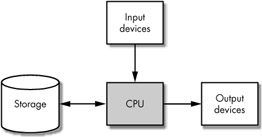Architecture of the Linux Enterprise Cluster
Let's use Pfister's statement that all clusters should act like "a single unified computing resource" to describe the architecture of an enterprise cluster. One example of a unified computing resource is a single computer, as shown in Figure 1.

Figure 1: Simplified architecture of a single computer
If we replace the CPU in Figure 1 with "a collection of interconnected whole computers," the diagram could be redrawn as shown in Figure 2.

Figure 2: Simplified architecture of an enterprise cluster
The load balancer replaces the input devices. The shared storage device replaces a disk drive, and the print server is just one example of an output device. Let's briefly examine each of these before we describe how to build them.
The Load Balancer
The load balancer sits between the users of the cluster and the "whole computers," which are the nodes that make up the cluster. The load balancer decides how best to distribute the incoming workload across all of the nodes.
In an enterprise cluster, user-based transactions make up the incoming workload. As users make connections to the cluster, such as HTTP web requests or telnet connections, they are assigned to cluster nodes based upon a load-balancing scheme (see Chapter 11).
The Shared Storage Device
The shared storage device acts as the single repository for the enterprise cluster's data, just as a disk drive does inside a single computer. Like a single disk drive in a computer, one of the most important features of this storage device is its ability to arbitrate access to the data so that two programs cannot modify the same piece of data at the same time. This feature is especially important in an enterprise cluster because two or more programs may be running on different cluster nodes at the same time. An enterprise cluster must therefore use a filesystem on all cluster nodes that can perform lock arbitration. That is, the filesystem must be able to protect the data stored on the shared storage device in order to prevent two applications from thinking they each have exclusive access to the same data at the same time (see Chapter 16).
The Print Server
The output device in this example is just one of many possible cluster output devices—a shared print server. A shared print server and other servers that offer services to all cluster nodes are located outside the cluster to arbitrate contention for things like printers, fax lines, and so on. Servers that arbitrate contention for output devices do not know they are servicing cluster nodes and can continue to use the classic client-server model for network communication. As we'll see in the next section, all of the server functions required to service the cluster nodes can be consolidated on to a single highly available server pair.
EAN: 2147483647
Pages: 219